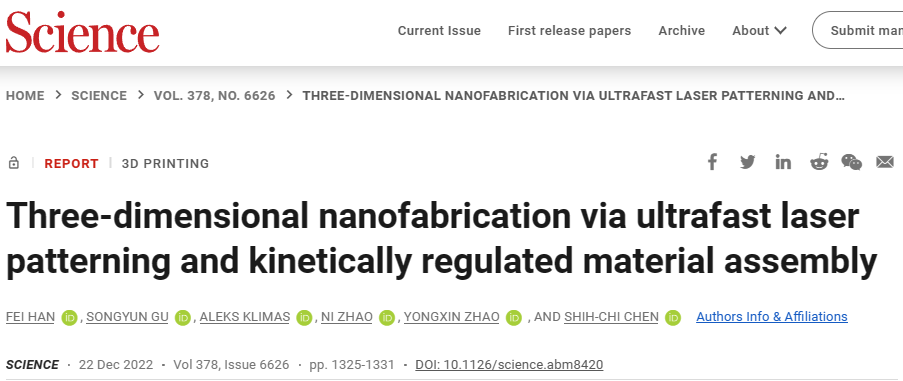XFNANO Au/Silver nanoparticles appear in Science
Self-assembly is a process in which the basic units (molecules, nanoparticles, etc.) of materials are assembled into ordered structures under the guidance of specific driving forces and the selective limits of sites. It has abundant regulatory mechanisms in nanochemistry. But assembling arbitrary three-dimensional nanostructures remains a top challenge because chemical synthesis lacks the means to design and assemble product shapes on demand.
On December 22, 2022, Top Journal Science reported the work of Han Fei, a postdoctoral fellow at the Chinese University of Hong Kong, a client of Synfeng. They used hydrogen bonds in hydrogels as the driving force for induced assembly, and determined the pattern shape by laser exposure in the gel. In the exposure area, the peak-energy laser partially destroys the gel skeleton through the photoionization effect, forming a new hydrogel mesh structure with controllable pore size. Through the steric hindrance, a dynamic effect, the size-matched nanoparticles can be selectively captured and assembled into a predetermined pattern.

Because all materials that can be dispersed in water have the ability to form hydrogen bonds, and because size is an intrinsic property of all nanoparticles, this method opens up the best material universality in micro and nano processing, processing more than 20 different materials such as metals, ceramics, upconversion materials, two-dimensional materials, semiconductors, diamonds, biomaterials, and even inks. And can maintain the original properties of the material (conductivity, photoluminescence, dielectric properties, etc.). Due to the contractile properties of hydrogels, combined with the chemical modification on the surface of nanoparticles, the method can easily break the diffraction limit and produce complex 3D structures with an accuracy of 20-30 nm.
This study is the first to apply dynamic control in nanochemistry to 3D micro/nano processing, overcome the problems of material diversity and machining accuracy, and provide a new possibility for the design of complex nanodevices.
In this work, XFNANO's products are Ag nanoparticles (5nm, 10-20nm, 20nm), Au nanoparticles (5nm, 10-20nm, 20nm), TiO2 nanoparticles 15 nm, sulfur quantum dots.
Article Title: Fei Han et al. Three-dimensional nanofabrication via ultrafastlaser patterning and kinetically regulatedmaterial assembly.science, 378, 1325 -- 1331 (2022).
Link: DOI: 10.1126/science.abm8420.

